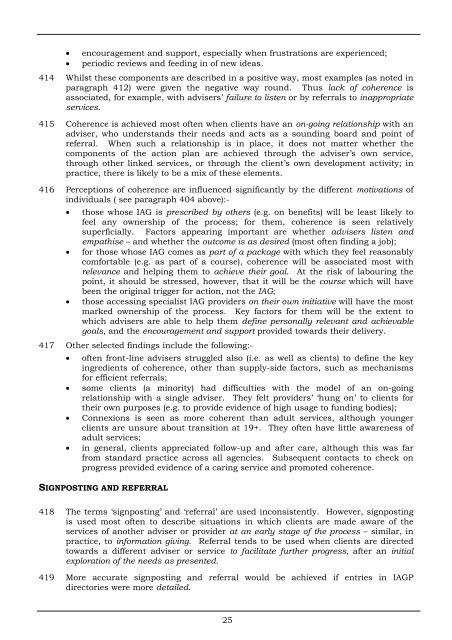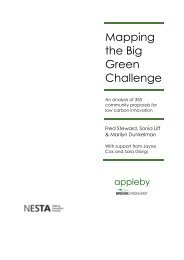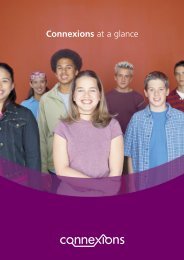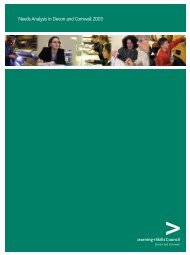Client needs for coherent information, advice and guidance services ...
Client needs for coherent information, advice and guidance services ...
Client needs for coherent information, advice and guidance services ...
Create successful ePaper yourself
Turn your PDF publications into a flip-book with our unique Google optimized e-Paper software.
• encouragement <strong>and</strong> support, especially when frustrations are experienced;<br />
• periodic reviews <strong>and</strong> feeding in of new ideas.<br />
414 Whilst these components are described in a positive way, most examples (as noted in<br />
paragraph 412) were given the negative way round. Thus lack of coherence is<br />
associated, <strong>for</strong> example, with advisers’ failure to listen or by referrals to inappropriate<br />
<strong>services</strong>.<br />
415 Coherence is achieved most often when clients have an on-going relationship with an<br />
adviser, who underst<strong>and</strong>s their <strong>needs</strong> <strong>and</strong> acts as a sounding board <strong>and</strong> point of<br />
referral. When such a relationship is in place, it does not matter whether the<br />
components of the action plan are achieved through the adviser’s own service,<br />
through other linked <strong>services</strong>, or through the client’s own development activity; in<br />
practice, there is likely to be a mix of these elements.<br />
416 Perceptions of coherence are influenced significantly by the different motivations of<br />
individuals ( see paragraph 404 above):-<br />
• those whose IAG is prescribed by others (e.g. on benefits) will be least likely to<br />
feel any ownership of the process; <strong>for</strong> them, coherence is seen relatively<br />
superficially. Factors appearing important are whether advisers listen <strong>and</strong><br />
empathise – <strong>and</strong> whether the outcome is as desired (most often finding a job);<br />
• <strong>for</strong> those whose IAG comes as part of a package with which they feel reasonably<br />
com<strong>for</strong>table (e.g. as part of a course), coherence will be associated most with<br />
relevance <strong>and</strong> helping them to achieve their goal. At the risk of labouring the<br />
point, it should be stressed, however, that it will be the course which will have<br />
been the original trigger <strong>for</strong> action, not the IAG;<br />
• those accessing specialist IAG providers on their own initiative will have the most<br />
marked ownership of the process. Key factors <strong>for</strong> them will be the extent to<br />
which advisers are able to help them define personally relevant <strong>and</strong> achievable<br />
goals, <strong>and</strong> the encouragement <strong>and</strong> support provided towards their delivery.<br />
417 Other selected findings include the following:-<br />
• often front-line advisers struggled also (i.e. as well as clients) to define the key<br />
ingredients of coherence, other than supply-side factors, such as mechanisms<br />
<strong>for</strong> efficient referrals;<br />
• some clients (a minority) had difficulties with the model of an on-going<br />
relationship with a single adviser. They felt providers’ ‘hung on’ to clients <strong>for</strong><br />
their own purposes (e.g. to provide evidence of high usage to funding bodies);<br />
• Connexions is seen as more <strong>coherent</strong> than adult <strong>services</strong>, although younger<br />
clients are unsure about transition at 19+. They often have little awareness of<br />
adult <strong>services</strong>;<br />
• in general, clients appreciated follow-up <strong>and</strong> after care, although this was far<br />
from st<strong>and</strong>ard practice across all agencies. Subsequent contacts to check on<br />
progress provided evidence of a caring service <strong>and</strong> promoted coherence.<br />
SIGNPOSTING AND REFERRAL<br />
418 The terms ‘signposting’ <strong>and</strong> ‘referral’ are used inconsistently. However, signposting<br />
is used most often to describe situations in which clients are made aware of the<br />
<strong>services</strong> of another adviser or provider at an early stage of the process – similar, in<br />
practice, to in<strong>for</strong>mation giving. Referral tends to be used when clients are directed<br />
towards a different adviser or service to facilitate further progress, after an initial<br />
exploration of the <strong>needs</strong> as presented.<br />
419 More accurate signposting <strong>and</strong> referral would be achieved if entries in IAGP<br />
directories were more detailed.<br />
25











